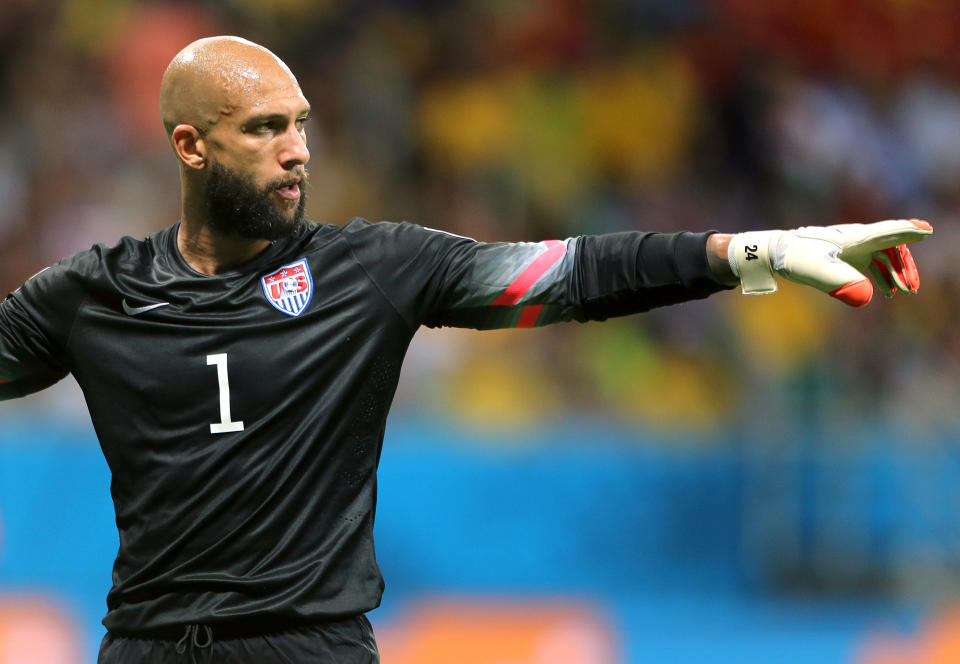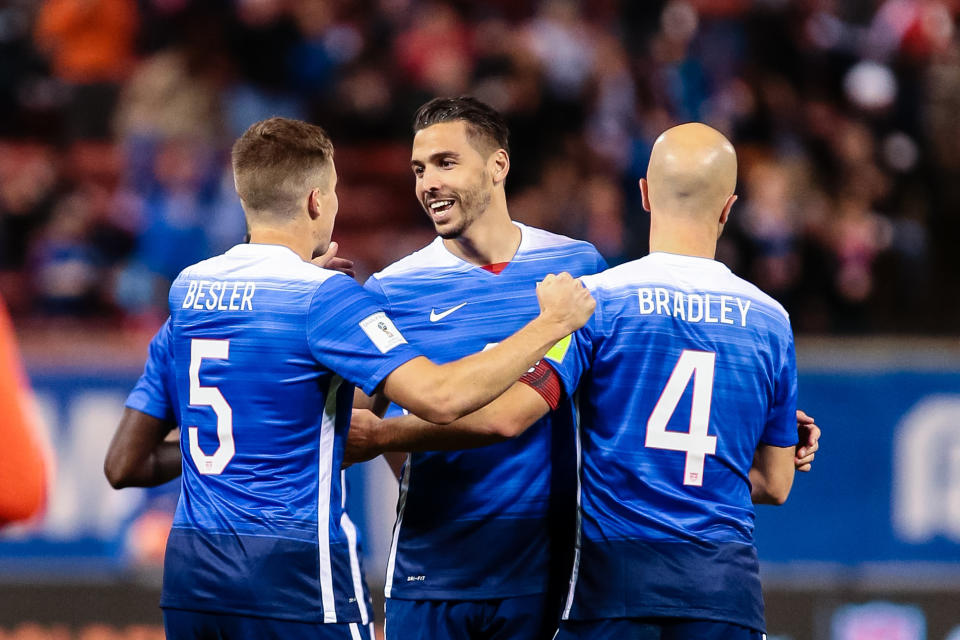The USMNT best XI of the 2010s
It was a decade of record-setting highs and soul-crushing lows for the United States men’s national team. At South Africa 2010, the USMNT won a World Cup group for the first time, beating out England for the top spot before falling to Ghana in extra time in the round of 16.
Four years later in Brazil, the Americans emerged from the Group of Death alongside eventual champion Germany, marking the first time the U.S. advanced to the knockout stage at consecutive World Cups.
A fourth-place finish at the 2016 Copa America Centenario on home soil followed, but disaster struck in 2017 when the program’s run of seven straight World Cup appearances ended on a waterlogged field in Trinidad — a calamity even the emergence of a bona fide all-world attacker (Christian Pulisic) couldn’t prevent.
The USMNT has been picking up the pieces ever since, with Gregg Berhalter — the national team’s fifth coach since 2010 — ending his first full year on the job with decidedly mixed results, including a loss to Mexico in July’s CONCACAF Gold Cup final.
Yep, it’s been an interesting 10 years to say the least. And it’s no wonder then that Yahoo’s USMNT XI of the 2010s skews to the earlier part of the decade, with the players who formed the core of the 2014 and 2016 rosters getting most of the love, with Pulisic the only obvious exception.
Note: 4-3-3 formation

Goalkeeper: Tim Howard
This one is a no-brainer. Howard backstopped the Americans to a first-place finish in the Hexagonal in 2013, the third time in as many cycles that the U.S. beat out El Tri for the region’s top spot, and he was light-out brilliant in Brazil. Howard kept his team in the 2014 opener as the red, white and blue exacted revenge on the Ghanaians, and he registered a World Cup-record 15 saves in the 2-1 extra time defeat to Belgium in the round of 16 — a performance that made the “Secretary of Defense” a household name stateside.
Howard took a sabbatical from international play after that, and he sat behind Brad Guzan at the Copa when he returned. But he had reclaimed his starting job by the time the next Hex rolled around and was in the net on that fateful night in Couva, one of the few blemishes on an otherwise pristine career.
Defender: Fabian Johnson
The soft-spoken German-American’s commitment to the national team was often questioned, but the two-footed Johnson was the program’s top fullback option for most of the decade. He broke into the squad under Jurgen Klinsmann in 2012 and was arguably the USMNT’s best player in Brazil — and possibly the best right back at that tournament.
He manned the opposite corner two years later at the Copa, where the U.S. beat Costa Rica, Paraguay and Ecuador before falling to Lionel Messi and Argentina in the semifinals, and he remained a starter into 2018 qualifying before being dropped by Bruce Arena ahead of the final fixture window.
Defender: Geoff Cameron
One of the USMNT’s few Premier League regulars during the 2010s, Cameron broke into the starting lineup for his country in 2012 and spent most the decade there. The big center back — who was occasionally deployed at right back and as a defensive midfielder — was a fixture during 2014 qualifying and started three of the Americans’ four games at the main event. He also played every minute of the Copa America.
Defender: Matt Besler
The left-footed Kansas native spent much of the 2010s as a lock in central defense, with Besler amassing 47 caps between 2013 and 2017. He started every game for Klinsmann in Brazil, and showed his versatility at the Copa two years later by playing left back in the knockout round win over Ecuador. Besler kept his place when Arena took over from Klinsmann two games into the Hex, and he was probably the Americans’ best player besides Pulisic in that devastating loss to the Soca Warriors.

Defender: DaMarcus Beasley
Beasley’s international career looked all but over following the 2010 World Cup, at which he played just 11 minutes off the bench for Bob Bradley. But the longtime winger got a new lease on life after reinventing himself as a left back. Beasley took over the position in the scoreless draw at Mexico’s imposing Azteca Stadium during 2014 qualifying and never let it go, playing every minute for the U.S. in Brazil. And he remained on the squad after Arena replaced Klinsmann, and probably would’ve been named to a fifth World Cup squad had the Americans not failed to make the cut for Russia 2018.
Midfielder: Michael Bradley
By age 22, Bradley had become one the the most important U.S. players — the Americans wouldn’t have advanced at the 2010 World Cup if not for the central midfielder’s second-half equalizer against Slovenia. Bob Bradley’s son was a mainstay under Klinsmann and Arena, too, serving as the squad’s full-time captain under both men, and he heads into the 2020s a starter under Berhalter.
Midfielder: Jermaine Jones
Jones missed the 2010 World Cup through injury after switching allegiance from Germany — for whom he appeared twice in the late 2000s — and made his much-anticipated U.S. debut that fall. Jones more than made up for lost time in 2014. The hard-tackling Champions League veteran was one of two outfield players to play every minute in Brazil (Bradley was the other), and his long-range screamer in the group stage tie with Portugal was the high point of the event for the Americans. Jones also started five games at the Copa America, only missing the loss to Messi and Co. because of suspension.
Midfielder: Christian Pulisic
It doesn’t say much about the current player pool that Pulisic and Bradley are the only active national teamers among this decade’s Best XI. But Pulisic would be there in any era — the 21-year-old’s emergence as one of the global game’s finest offensive talents this season for Chelsea is proof of that.
Pulisic carried the USMNT in 2017 as a teenager, almost single-footedly dragging the Americans to Russia himself, and he already has 14 goals in 34 international games despite playing mostly on the wings or in a playmaking role behind a central striker.

Forward: Landon Donovan
Donovan was famously left off the 2014 World Cup team by Klinsmannn, but he’s still an easy selection here. The Californian’s last-gasp goal against Algeria at the 2010 World Cup simultaneously staved off first-round elimination and won the Americans their group, and he stood alone as the program’s all-time top scorer when he played his 157th and final match for the U.S. five years ago.
Forward: Clint Dempsey
The rangy Texan scored at both the 2010 and 2014 World Cups — captaining his country at the latter — and tied Donovan’s mark of 57 goals at the 2017 CONCACAF Gold Cup while helping the U.S. to the title. (Dempsey would almost certainly own the record had a heart aliment not limited him to 10 appearances in 2016.)
He also emerged as a Premier League star with Fulham early in the decade, earning a high-profile transfer to Tottenham Hotspur in 2012. His final U.S. match also came in Couva, where he nearly saved the Americans as a second-half substitute. Alas, his late effort couldn’t beat the post.
Forward: Jozy Altidore
Altidore was a World Cup starter at 20, and was poised for a breakout 2014 tourney when he went down with a hamstring injury minutes into the Americans’ opener. Still, he scored all but eight of his 42 international goals during this decade, and he remains the national team’s top striker when he’s healthy.
Bench: Brad Guzan, Omar Gonzalez, John Brooks, Kyle Beckerman, Alejandro Bedoya, Jordan Morris
Guzan was Howard’s understudy at the 2010 and 2014 World Cups, started all but the third place match for the U.S. at the Copa America, and was in goal for the Yanks’ final two games of this year, both wins. Gonzalez was a regular under both Klinsmann and Arena. Brooks scored a World Cup game-winning goal during a 45-minute cameo in Brazil, was a beast at the Copa and is now the USMNT’s undisputed top defender.
Bedoya, meanwhile, was a starter on the 2013 Gold Cup-winning side as well as in the major tournaments of 2014 and 2016. Midfield destroyer Beckerman was among the USA’s top performers in Brazil, while Morris debuted in late 2014 as a college kid (scoring against Mexico while still at Stanford), notched the Gold Cup-winner in 2017 and emerged as an automatic starter under Berhalter this year, finishing just behind Pulisic in the USMNT’s player of the year voting.
More from Yahoo Soccer’s Best of 2010s

